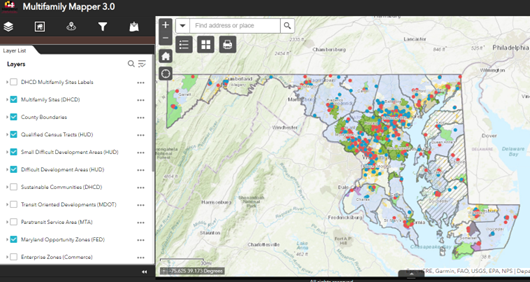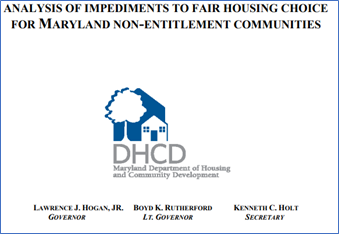Planning encourages Maryland jurisdictions to explore the multitude of resources that are already available to aid them in their fair housing planning efforts. Planning notes that Maryland’s towns, cities, and counties must determine for themselves, in partnership with stakeholders, how best to complete the assessment of fair housing, now required by HB 90. Every jurisdiction’s context is unique, and local planning capacities vary.
Potential resources are organized into five categories as described below, each with an explanation and link(s). Planning stresses that jurisdictions are not required to use these when completing fair housing assessments, since many may not apply because of a community’s unique context. They are included here to further public education on affirmatively furthering fair housing (AFFH) and because Planning wishes to share what it has learned and researched about the topic with the larger Maryland planning community.
Fair Housing Data and Mapping Resources
United States Census Bureau American Community Survey (ACS) Data and ACS Data Curated by the Maryland State Data Center: Many housing and land use characteristics can be derived from ACS data, such as vacancy rates, age of properties, number of bedrooms, monthly housing costs, number of occupants per room, and household size. Additionally, ACS data can help a community’s planners consider the prevalence of home ownership or rental opportunities, particularly as they relate to protected classes. Users can access data by their selected geography (county, place, census tract) for occupied housing units by owner or renter, or housing tenure by race and ethnicity. Examining this information on a map may help highlight disparities between locations where residents do or do not have access to homeownership opportunities, or where a more even mix prevails.
HUD’s Comprehensive Housing Affordability Strategy (CHAS) Data: HUD develops CHAS data from ACS data. CHAS data is an excellent source of information on households and housing units that need housing assistance, particularly low-income households, and is available at the county, place, and census tract levels. Using the CHAS query tool, planners can quickly access data on household income and households that have at least one of four housing problems, including incomplete kitchen and plumbing facilities, housing overcrowding, and housing cost burden. While CHAS data offers similar information as ACS data, it can be disaggregated by income level, owner versus renter, race, age, household size, and disability status.
HUD’s AFFH Mapping Tool (AFFH-T): This publicly available interactive mapping tool, developed by HUD, provides access to HUD-provided AFFH data. The AFFH-T allows users to build an AFFH map and export data tables for certain Maryland jurisdictions. The AFFH-T is incomplete in areas, but the AFFH webpage notes that HUD is continuously updating information and data in the tool. Available maps include race/ethnicity, national origin, Limited English Proficiency (LEP), housing problems, publicly supported housing, and other dot density maps, as well as maps displaying data on school proficiency, job proximity, transportation topics, and other demographic indicators that can inform when planning for fair housing. These maps display Racially or Ethnically Concentrated Areas of Poverty (R/ECAPs), which HUD defines as areas with a non-white population of 50% or more and with 40% or more individuals living at or below the poverty level. Planning encourages AFFH-T users to review the user guide and data documentation.
DHCD’s Multifamily Mapper: The Multifamily Mapper (Mapper) displays information about multifamily rental developments that were either renovated or newly constructed with financing from the Department of Housing and Community Development (DHCD) and other sources. The Mapper includes information on funding program types, closing dates, number of units by type, and primary occupancy. Tool users can overlay the location of multifamily sites with over a dozen housing and development designations, as determined by DHCD, state, and federal agencies. The Mapper can help communities further their AFFH goals by helping identify areas of opportunity and Priority Funding Areas and locating existing low-income multifamily housing opportunities for families, elderly, or those with special needs.

Maryland Department of the Environment (MDE) EJ Screening Tool: Planning introduced MDE’s EJ Screening Tool (EJ Screen) in our August, 2022 edition of Planning Practice Monthly. MDE developed the tool to enhance communication, outreach, and oversight of permitting activities in communities that may be overburdened and underserved, but it can also be used for AFFH planning purposes. The EJ Screen calculates EJ scores at the census tract level, which are based on three criteria: 1) percent minority distribution; 2) percent poverty distribution; and 3) percent Limited English Proficiency (LEP). Jurisdictions assessing fair housing, as required by HB 90, might consider using EJ Scores, or the criteria used to calculate them, to identify communities of concentrated racial poverty. Identifying such areas is a vital early step in fair housing planning.
Community Engagement and Jurisdiction Self-reflection
In addition to gathering fair housing data, jurisdictions should engage residents and other stakeholders (e.g., public housing authorities, community development corporations) in a local and often regional dialogue about fair housing. The input solicited as part of this process can both inform and be informed by the quantitative data gathered through the sources described above. Some questions that jurisdictions may want to consider asking stakeholders, as well as local government staff members, include:
- Do we have residential patterns of racial/ethnic concentration?
- For municipalities, how do our racial/ethnic composition & patterns compare to the county? For counties, how do our racial/ethnic composition & patterns compare to the metropolitan area?
- If there are areas of concentration, are any of these areas combined with high levels of poverty or low-income households?
- How do these areas of concentration compare with measures of access to opportunity, such as education outcomes, levels of employment/unemployment, levels of education, percent vacant homes, and/or amount of nearby employment?
- If these areas of concentration correlate with lower access to opportunity, how do they compare with our zoning? Does our zoning allow multi-family homes outside of those areas?
- Do we have publicly assisted housing? (e.g. Low Income Housing Tax Credit, HOME, CDBG, HUD-funded)
- Are there racial gaps in homeownership rates in our jurisdiction?
- What do local stakeholders think of this information? Do they have other suggested sources of info that could be helpful to us in this analysis?
Analysis of Fair Housing
 State of Maryland 2015 Analysis of Impediments (MD 2015 AI) to Fair Housing Choice for Maryland Non-Entitlement Communities: The Maryland Department of Housing and Community Development (DHCD) completed this analysis to meet HUD requirements to assess the State of Maryland’s and DHCD’s work to ensure fair housing for residents of federally protected classes. For more on the distinction between entitlement and non-entitlement communities, please see DHCD’s Community Development Block Grant Program webpage. The MD 2015 AI uses census, HUD, DHCD, Maryland Department of Health, and Maryland State Data Center Data, as well as Home Mortgage Disclosure Act and private data, to analyze fair housing successes, progress, and barriers in Maryland. The document uses this analysis to consider state policies and actions needed to further fair housing, including recommendations in the areas of funding, marketing, public education, housing staff training, and others. Jurisdictions developing a local assessment of fair housing may want to consider modeling their approach, albeit at a scaled down level, on the methodology used in the MD 2015 AI.
State of Maryland 2015 Analysis of Impediments (MD 2015 AI) to Fair Housing Choice for Maryland Non-Entitlement Communities: The Maryland Department of Housing and Community Development (DHCD) completed this analysis to meet HUD requirements to assess the State of Maryland’s and DHCD’s work to ensure fair housing for residents of federally protected classes. For more on the distinction between entitlement and non-entitlement communities, please see DHCD’s Community Development Block Grant Program webpage. The MD 2015 AI uses census, HUD, DHCD, Maryland Department of Health, and Maryland State Data Center Data, as well as Home Mortgage Disclosure Act and private data, to analyze fair housing successes, progress, and barriers in Maryland. The document uses this analysis to consider state policies and actions needed to further fair housing, including recommendations in the areas of funding, marketing, public education, housing staff training, and others. Jurisdictions developing a local assessment of fair housing may want to consider modeling their approach, albeit at a scaled down level, on the methodology used in the MD 2015 AI.
Baltimore Metropolitan Council's 2020 Analysis of Impediments to Fair Housing Choice in the Baltimore Region (BMC 2020 AI): The BMC 2020 AI includes a comparable analysis to DHCD’s 2015 AI, but for the Baltimore Region. This document details and measures the success of local fair actions and goals, including demographic patterns and disparities in access to opportunity. The BMC 2020 AI includes sections on zoning, land use, and fair housing enforcement which may inform similar sections in housing elements. The appendices summarize stakeholder feedback and provide AFFH data tables that jurisdictions might consider replicating.
Assessment Tool of Fair Housing Tool for Local Governments: The AFFH webpage describes the assessment tool as to be used “by local government and any collaborating program participants that choose to conduct and Assessment of Fair Housing (AFH).” The tool, while more extensive than needed for most jurisdictions completing a housing element in line with the requirements of Land Use Article §3-114, provides helpful prompts and suggestions for assessing existing and previous fair housing actions, analyzing fair housing conditions, and developing fair housing goals and priorities.
Fair Housing Goals, Policies, Actions, and Best Practices
HB 90 added the following language to §2-401 of the Housing and Community Development Article.